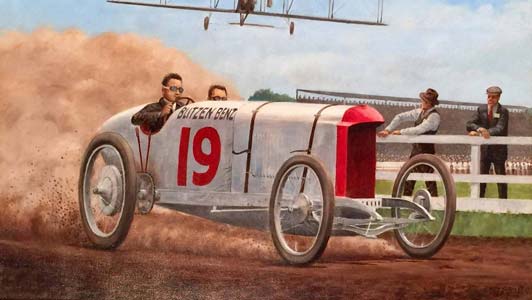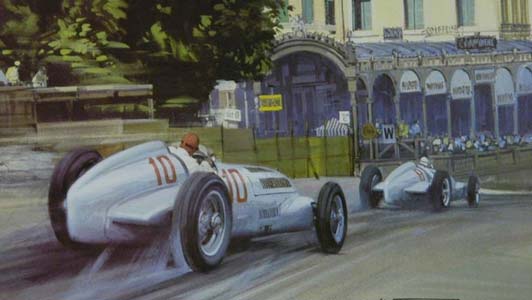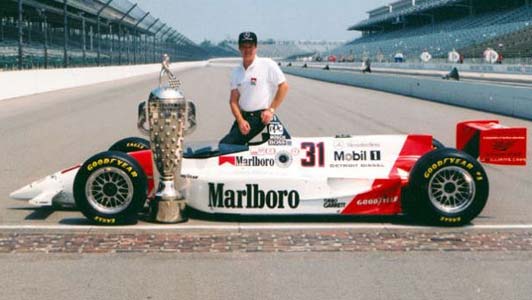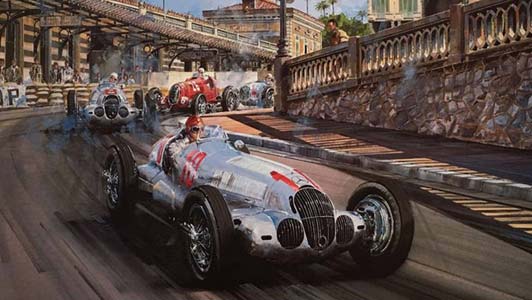Celebrate more than 120 years of Racing Heritage with arteauto.com
by James Karthauser
Ever since motor racing began in the late 1800’s, Mercedes and Benz have been participating and winning. As they joined their efforts together the tradition continued and in the last 120+ years they have been very successful indeed. With only a few interruptions, due to wars or accident, the Marque from Stuttgart has championed successfully over many competitors and in all forms of racing they have entered, even to this day.
Both Marques, Daimler-Motoren-Gesselsvhaft and Benz Patent-Motorwagen, independently enjoyed success in the sport of motor racing throughout their separate histories. A single Benz competed in the world's first motor race, the 1894 Paris–Rouen, where Émile Roger finished 14th in 10 hours 1 minute. The Mercedes Simplex of 1902, built by DMG, was Mercedes' first purpose built race car — much lower than their usual designs — which were similar to horse carriages; that model dominated racing for years. In 1914, just before the beginning of the First World War, the DMG Mercedes 35 hp won the French Grand Prix, finishing 1-2-3.
 |
| Blitzen Benz - Oil on Canvas Painting by Fred Stout, available in the collection of l'art et l'automobile |
Karl Benz's company, Benz & Cie. built the "bird beaked", Blitzen Benz that set land speed records several times, reaching 141.7 mph in 1911. That record gained that model the reputation of being faster than any other automobile — as well as any train or plane. They were already constructing many aerodynamically designed race cars.
Grand Prix Racing and the Rise of the Silver Arrows
Despite a promising start, with a fourth and a fifth in their debut, they did no better in three years of Grands Prix and hillclimbing, and the expected public acceptance did not materialize. Financial difficulties led to a merger with Daimler.
 |
| G.P. of Monaco 1937 print by Michael Turner, available in the collection |
But when the two companies were merged to form the Mercedes-Benz brand in 1926, they continued their relentless campaign of excellence.
In the 1930s, the new joint company, Daimler-Benz, with their mighty Mercedes-Benz Silver Arrows, dominated Grand Prix racing in Europe together with its rival, Auto Union. In fact the colour of the cars, which was later to become legendary, was unintentional - they had initially been painted white as was traditional for German cars, but the paint was stripped away to reduce weight. The cars set speed records up to 270 mph. The team was guided by the great racing team manager Alfred Neubauer until the company ceased racing at the start of WWII.
Formula 1 Racing
In 1954 Mercedes-Benz returned to what was now known as Formula One racing, in which a World championship having been established in 1950, using the technologically advanced Mercedes-Benz W196 which was run in both open-wheeled and streamlined forms. Juan Manuel Fangio, a previous champion (1951) transferred mid-season from Maserati to Mercedes-Benz for their debut at the French Grand Prix on 4 July 1954. The team had immediate success and recorded a 1-2 victory with Fangio and Karl Kling, as well as the fastest lap, set by Hans Herrmann. Fangio went on to win three more races in 1954, winning the Championship. |
| Fangio's Mercedes 300 SLR, 1955 Le Mans autographed photo, available in the collection |
The success continued into the 1955 season, where the same car was used again. The team's drivers, Fangio and the young Stirling Moss, won 6 of the 9 rounds between them, and finished first and second in that year's championship.
Following the 1955 Le Mans disaster, Mercedes-Benz withdrew from all factory-sponsored motorsport.
Mercedes made its return to Formula One in 1994 as an engine supplier to Sauber, with whom they had already enjoyed success in sportscar racing, after 1993 funding their engine partner Ilmor, Mercedes and Sauber announced that the teams engines will be rebadged "Mercedes-Benz" for the 1994 season signaling Mercedes return in participation of the series for the first time since 1955. In 1995 they began supplying engines to the McLaren team, which truly started the resurgence of the brand. Outside Formula One, Mercedes-Benz had increased its shareholding in the Ilmor company in 1996 and took full control nine years later, eventually rebranding as Mercedes AMG High Performance Powertrains. They have continued to design and build engines for McLaren.
In the opening race of the 1997 Formula One season, David Coulthard produced victory for McLaren and ushered in a new era of success for the British based squad. Coincidentally this was the first race in which McLaren had competed with a silver livery due to West replacing Marlboro, who moved to Ferrari, as title sponsor. The colour drew inevitable comparisons to the Silver Arrows of a previous era, and the nickname was applied to the McLarens. This was a significant result in F1 racing, McLaren's first victory for three seasons and the first win for Mercedes-Benz since Juan Manuel Fangio's success at the 1955 Italian Grand Prix.
 |
| Michael Schumacher and Nico Rosberg running 1&2 in Mercedes' triumphant return to Formula 1 |
On November 16, 2009, it was announced that Mercedes would part ways with McLaren, and instead purchase a 75% controlling stake in the 2009 championship-winning team Brawn GP. The team, reimagined as Mercedes GP, debuted at the 2010 Bahrain Grand Prix, with an all-German driver line-up of Nico Rosberg and Michael Schumacher.
It was in 1952 that Mercedes-Benz returned to racing after the war, again with Alfred Neubauer as team manager. Their small and underpowered gull-winged Mercedes-Benz 300SL, won several races in 1952 including the 24 Hours of Le Mans, the Carrera Panamericana, and did well in other important races such as the Mille Miglia.
Sports Car Racing
It was in 1952 that Mercedes-Benz returned to racing after the war, again with Alfred Neubauer as team manager. Their small and underpowered gull-winged Mercedes-Benz 300SL, won several races in 1952 including the 24 Hours of Le Mans, the Carrera Panamericana, and did well in other important races such as the Mille Miglia.
 |
| 24 Hours of Le Mans 1955 large photograph, available in the collection of l'art et l'automobile |
Mercedes-Benz was also dominant in sports car racing during the 1950s. The Mercedes-Benz 300 SLR was derived from the W196 Formula One car for use in the 1955 World Sportscar Championship season. At Le Mans that year, a disaster occurred in which a Mercedes-Benz 300 SLR collided with another car, killing more than eighty spectators. In fact in the aftermath of the Le Mans disaster, it would be several decades until Mercedes-Benz returned to front line motorsport.
In the late 1960s and early 1970s, Mercedes returned to competition through the tuning company AMG, later to become a Mercedes-Benz subsidiary, which entered the big Mercedes-Benz 300SEL 6.3 V8 sedan in the Spa 24 Hours and the European Touring Car Championship.
In 1985 Mercedes-Benz returned to the World Sportscar Championship as an engine supplier for the privateer Sauber team. The first car produced by this relationship, the Sauber C8 was not particularly successful. However the successor, the C9 won several races, including 24 Hours of Le Mans in 1989.
In the late 1960s and early 1970s, Mercedes returned to competition through the tuning company AMG, later to become a Mercedes-Benz subsidiary, which entered the big Mercedes-Benz 300SEL 6.3 V8 sedan in the Spa 24 Hours and the European Touring Car Championship.
In 1985 Mercedes-Benz returned to the World Sportscar Championship as an engine supplier for the privateer Sauber team. The first car produced by this relationship, the Sauber C8 was not particularly successful. However the successor, the C9 won several races, including 24 Hours of Le Mans in 1989.
 |
| 1986 24 Heures du Mans Original Poster, available in the collection |
Mercedes-Benz returned to prominence in sportscar racing in 1997, with the CLK GTR which was entered in the new FIA GT Championship world championship series. In its first year, the CLK GTR won the championship and the drivers' championship. It would again dominate the FIA GT in 1998, and would go on to win its second championship in a row. The CLK GTR would be the last car to win the FIA GT Championship.
In 2011, Mercedes-Benz announced that a GT3 version of the Mercedes-Benz SLS AMG would be made available for private racing teams. Beginning that year, the SLS AMG GT3 has taken numerous endurance racing wins at the 24 Hours of Dubai, 24 Hours of Nürburgring and 24 Hours of Spa and has won many other races in national and global GT3 championships. In 2015, the new Mercedes-AMG GT3 was launched to replace the SLS AMG GT3.
IndyCar
In 1994, Al Unser, Jr. won the Indianapolis 500 with a Penske-Mercedes IndyCar. Mercedes-Benz which, realizing that a loophole in the rules for production-based engines would include any pushrod engine, built a very unusual purpose-built pushrod engine with a significant power advantage. This was done knowing that the "forgotten" loophole would be closed immediately after they took advantage of it, and so the engine would in fact be usable only for this single race.
 |
| Al Unser, Jr at the Indy 500 in 1994 |
Starting from 1995, Mercedes-Benz rebranded the Ilmor engines and achieved six wins in their first full season, also reaching second in the drivers championship powering Al Unser, Jr. After a dry spell in 1996, Mercedes-Benz came back in 1997 with eight wins and winning the Manufacturer's Championship. However, a lack of competitive results in the following seasons and the CART/IRL split meant Mercedes gradually lost interest and the German manufacturer abandoned American racing at the end of the 2000 season, with a total of 18 wins and one driver runner-up finish in the CART championship.
Speed Records
On 28 January 1938, Rudolf Caracciolo set a Land Speed Record of 268 mph over the flying kilometer, Mercedes-Benz W125 Rekordwagen was an experimental, high-speed automobile produced in the late 1930s. The streamlined car was derived from the 1937 open-wheel race car Mercedes-Benz W125 Formel-Rennwagen, of which also a streamlined version was raced at the non-championship Avusrennen in Berlin. This Record remained the fastest ever officially timed speed on a public road until broken on 5 November 2017 by Koenigsegg in an Agera RS driven by Niklas Lilja, achieving 276.9 mph on a closed highway in Nevada. It also was the fastest speed ever recorded in Germany until Rico Anthes bested it with a Top Fuel Dragster on the Hockenheimring drag strip.This record breaking run was made on the Reichs-Autobahn A5 between Frankfurt and Darmstadt, where onlookers were rattled by the brutal boom of the side spewing exhaust stacks as the silver car hurtled past. By nine that morning, Caracciola and team chief Alfred Neubauer were having a celebration breakfast at the Park Hotel in Frankfurt.
Sadly, popular driver Bernd Rosemeyer was killed later the same day when trying to beat that record for Auto Union. This also put an end to the record attempts of Mercedes, even though Hans Stuck later wanted to beat the overall land speed record with the Porsche-designed Mercedes-Benz T80 which was powered by a 3,000 horsepower (2,200 kW) airplane engine.
On August 13–21, 1983 at the Nardo High Speed Track in southern Italy, the new compact-size W201 190 class, sporting a 16-valve engine, built by Cosworth, broke three FIA world records after running almost non-stop in a total of 201 hours, 39 minutes, and 43 seconds—completing 31,000 miles at maximum speed of 153 mph. It went on to become the 190E 2.3-16 touring model.
Mercedes-Benz is currently active in four motorsport categories, Formula Three, DTM, Formula One and GT, even winning the Formula 1 Constructor's and Driver's Championship for the last four years.
 |
| Cars by Andy Warhol (W125) Poster, available in the collection of l'art et l'automobile |
Over the last 40+ years here at l’art et l’automobile, we have accumulated a vast collection of moments and memorabilia from Mercedes-Benz’s illustrious racing and production career, including many of their triumphs and successes over the decades.
Don't forget to head to our store site for more great automotive memorabilia. We have many more items in our gallery, so do not hesitate to contact us if you are looking for something in particular. And as always, Like and Share us on Facebook, Follow us on Twitter, Share a Picture with us on Instagram and catch up on the rest of the blog below.
James Karthauser
Social Media and Development
l’art et l’automobile
Don't forget to head to our store site for more great automotive memorabilia. We have many more items in our gallery, so do not hesitate to contact us if you are looking for something in particular. And as always, Like and Share us on Facebook, Follow us on Twitter, Share a Picture with us on Instagram and catch up on the rest of the blog below.
James Karthauser
Social Media and Development
l’art et l’automobile

Interesting stuff to read.Keep it up.Used Volvo S60 Cars For Sale
ReplyDeleteyet in 2007 there was a sensational improvement again and they increased high positions once more, outperforming rival Toyota yet at the same time behind Lexus. used car dealerships near me
ReplyDeleteour precious automobile requires safety, proper care and our great vigilance. Also, vehicle theft is almost common in all the countries of the world and can cause you a loss of hefty sum of money, if by chance you lose your vehicle.fanuc spare parts
ReplyDeleteGet the latest and greatest navigation for your Mercedes-Benz https://www.tesvikiyegaraj.com.tr/
ReplyDeleteThis old model racing Mercedes car is really amazing. And I KNOW about the speed of this car. And engine quality is too good so if you want to make any modify of this car then you should go mercedes workshop it is the best place to modify any Mercedes car in a reasonable price.
ReplyDeleteThank you very much for writing such an interesting article on this topic. This has really made me think and I hope to read more.
ReplyDeleteview this website
Excellent Blog! Mercedes Car Leasing
ReplyDeleteIt’s very informative and you are obviously very knowledgeable in this area. You have opened my eyes to varying views on this topic with interesting and solid content. Sell Car Plates
ReplyDeleteI think this is one of the most significant information for me. And i’m glad reading your article.Car Consignment
ReplyDeleteOur priority is to satisfy the needs of our customers by offering a wide selection of vehicles from a variety of manufacturers to suit their needs. traverse city car dealers,
ReplyDeleteI once had the advantage of possessing a 1999 Mercedes C43 AMG, completely tweaked and decorated with all the most recent Mercedes parts that procured it an AMG identification. identity theft protection
ReplyDeleteThis article is so much informative and helpful, I would like to share it....
ReplyDeletecar valuation
free car valuation
online car valuation
car valuation
free car valuation
online car valuation
Very nice post thanks for share us.Car Plates
ReplyDelete